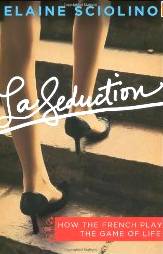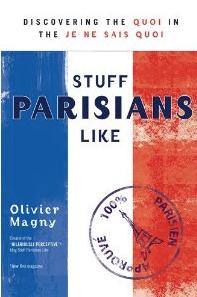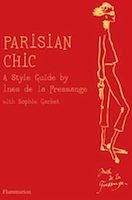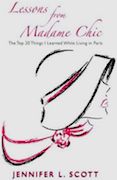Book Review: La Seduction by Elaine Sciolino
- SUBSCRIBE
- ALREADY SUBSCRIBED?
BECOME A BONJOUR PARIS MEMBER
Gain full access to our collection of over 5,000 articles and bring the City of Light into your life. Just 60 USD per year.
Find out why you should become a member here.
Sign in
Fill in your credentials below.
 Book Review: La Seduction
Book Review: La Seduction
Published June 2011; 352 pages
Publisher: Times Books
Language: English
By Anne McCarthy
In writing La Seduction: How the French Play the Game of Life, author Elaine Sciolino played the role of seductress to dignitaries, former supermodels and everyday Parisians. She charmed her subjects to extract information from them for another subject: her latest book, La Seduction, which covers the theme of, what else, seduction.
Sciolino served as Paris bureau chief for the New York Times, Newsweek magazine writer and she received the Legion of Honor for her work in fostering positive relations between France and the United States. Sciolino is one of the few non-French women in Femmes Forum, a Paris-based private club of 200 notable French women. She currently lives in Paris with her husband and their two daughters.
This book was written in five parts that run the gamut from “Prolonging the Moment” (Part Two) to “Seduction and Public Life” (Part Four). Sciolino opens the first page of her book with an appropriate quote from French Enlightenment writer and philosopher, Voltaire, who said, “It is not enough to conquer, one must also know how to seduce.”
From that first page, Sciolino launches into a thorough and intricate examination of seduction, as used by the French in their daily lives. One of the author’s first examples of “la seduction” details an interaction she had with the then-President of France, Jacques Chirac, in 2002 at the Élysées Palace. Upon introduction, Chirac reached out and grabbed Sciolino’s hand and kissed it, with his lips pressed firmly against her skin. Chirac was famous for this seductive tactic, practicing it on other prominent female figures, from Condoleezza Rice to Laura Bush.
This kissing of her hand, un baiseman, created mixed emotions within Sciolino. She was flattered, yet uncomfortable. This moment, among others, would become the impetus for a more thorough exploration of the French notion of seduction.
The author informs the reader that “seduction” and “seduire” (to seduce) are among the most overused words in the French language, proof that this is a prominent quality of French culture and its people. Sciolino writes, “They [the French] give themselves permission to fulfill a need for pleasure and leisure that America’s hard-working, super capitalist, abstinent culture often does not allow…For the French, this is part of the frisson of life.”
As an example of this outlook—the value of pleasure in French culture versus the lack of pleasure in American culture—Sciolino points to President Obama’s 2009 visit Paris to commemorate the anniversary of the Normandy Beach landings. Obama was asked by a reporter why he was spending so little time in Paris, to which the President replied that he had too much to do, and there was no time to enjoy himself.
The author’s search for seduction was aided by the help of a varied roster of French friends. Among them was Ines de La Fressange, former supermodel for Chanel, and like Scolinio, a recipient of France’s Legion of Honor. La Fressange recommended that the author take a French lover to aid in her study and exploration of “la seduction.” Scolinio declined, informing the former supermodel that she had a husband and children. So, over breakfast with her husband, Andy, Scolinio wrote a list of possible candidates to be her “virtual lovers,” French men who could provide her insight, sans a torrid affair.
In her research, with the aid of French men and women alike, Sciolino examined the theme of process and how it plays into the notion of French seduction. It is evident to anyone who visits Paris: in French culture, there is an emphasis on form and process, over the outcome. This aspect of the culture is deeply-rooted and centuries-old. The reader learns, “France was the first European culture to create a culture of love in the Middle Ages.”
There is a commitment to thoroughness, more so than the final outcome, that exists as a staple of French life. Sciolino explains that this is all part of seduction: the desire, the build-up of any task or event, is far greater than the result. It is believed that seduction should be tended to and exhibited on a daily basis, as a way to create greater excitement and enjoyment of life.
Daily forms of seduction can be found in the simplest of actions. Most notably, there is the infamous “bise,” the bisoux, one kiss on each cheek as a routine way to say hello and goodbye. Though standard in practice and executed casually, Sciolino’s French friends insisted “the bise” holds “extraordinary power.” It is a tool for subtle seduction. The French place great importance not only on love romance, but romantic notions that take on the form of roses, perfume, chocolates and even fine cheeses. A casual stroll down rue Mouffetard in the Latin Quarter or rue de Rosiers in the Marais will provide one with a smattering of these types of romantic pleasures.
Other ideas Sciolino stumbled upon in her research, and her conversations with the French, were the notion of the Eiffel Tower as a woman. Rather than viewing the Tower as a phallic symbol, the French insist it should be seen as a female human form, saying, “she astounds with her statue and looks.” There is also the idea of the emphasis on beauty, and how it can be seen in most everyday tasks, right down to handwriting, as an example of French presentation and a dedication to aesthetics. Following the idea of presentation, is the advent of the sugar cube, which the French claim they invented. France even celebrated the 60th anniversary of the “morceau de sucre” in 2009. In France, there exists the desire to make everything beautiful: sugar, language and Chanel.
La Seduction: How the French Play the Game of Life is a fascinating and well-researched read for anyone interested in French culture. It is beautifully written (something the French would approve of) and a thoroughly worthwhile read. Reading Sciolino’s book, called to mind the famous E.B. White quote, “Humor can be dissected as a frog can, but the thing dies in the process.”
Seduction is perhaps best left to be practiced and not to be examined too closely.
Anne McCarthy is an American writer now living in Paris. She is a member of the Writers Group at Shakespeare and Company bookstore and she’s writing a humor memoir about her adventures in Paris. Please click on her name to learn more about her.
Would you like to submit a story or request a story topic? Your stories & ideas welcome.
NEW: exclusive content for subscribers in every newsletter. Subscribe for free.
Top 100 Readers’ Favorite Amazon.com Items. (Please wait for Amazon.com widget to load)
Click on image for more info about these favorites.
Direct airport transfer service
PARIS SHUTTLE is a leading Paris airport transfer service. Book your airport transfers in advance online for direct to-your-door service and check the current discount available to BonjourParis readers who book using our link.








